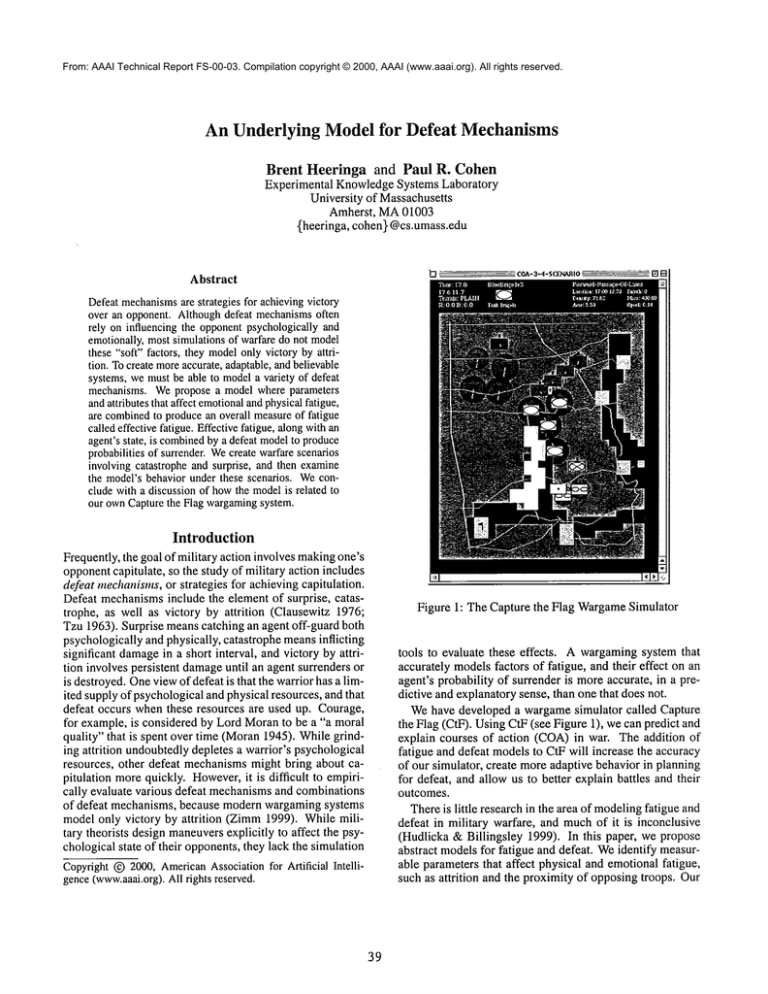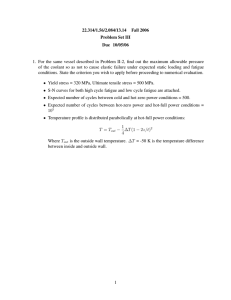
From: AAAI Technical Report FS-00-03. Compilation copyright © 2000, AAAI (www.aaai.org). All rights reserved.
An Underlying Model for Defeat Mechanisms
Brent Heeringa and Paul R. Cohen
Experimental KnowledgeSystems Laboratory
University of Massachusetts
Amherst, MA01003
{heeringa, cohen} @cs.umass.edu
COA3-4- S CEN,
A,RIO--
Abstract
[] []
Defeatmechanisms
are strategies for achievingvictory
over an opponent.Althoughdefeat mechanisms
often
rely on influencing the opponentpsychologicallyand
emotionally,mostsimulationsof warfaredo not model
these "soft" factors, they modelonlyvictory by attrition. Tocreate moreaccurate,adaptable,andbelievable
systems,wemustbe able to modela variety of defeat
mechanisms.Wepropose a model where parameters
andattributes that affect emotional
andphysicalfatigue,
are combined
to producean overall measureof fatigue
calledeffectivefatigue.Effectivefatigue, alongwithan
agent’sstate, is combined
by a defeat modelto produce
probabilities of surrender.Wecreate warfarescenarios
involving catastrophe and surprise, and then examine
the model’sbehaviorunder these scenarios. Weconclude with a discussionof howthe modelis related to
our ownCapturethe Flag wargaming
system.
Introduction
Frequently, the goal of military action involves makingone’s
opponentcapitulate, so the study of military action includes
defeat mechanisms,or strategies for achieving capitulation.
Defeat mechanismsinclude the element of surprise, catastrophe, as well as victory by attrition (Clausewitz 1976;
Tzu 1963). Surprise meanscatching an agent off-guard both
psychologically and physically, catastrophe meansinflicting
significant damagein a short interval, and victory by attrition involves persistent damageuntil an agent surrenders or
is destroyed.Oneviewof defeat is that the warrior has a limited supply of psychologicaland physical resources, and that
defeat occurs whenthese resources are used up. Courage,
for example, is considered by Lord Moranto be a "a moral
quality" that is spent over time (Moran1945). Whilegrinding attrition undoubtedlydepletes a warrior’s psychological
resources, other defeat mechanismsmight bring about capitulation morequickly. However,it is difficult to empirically evaluate various defeat mechanismsand combinations
of defeat mechanisms, because modern wargamingsystems
model only victory by attrition (Zimm1999). While military theorists design maneuversexplicitly to affect the psychological state of their opponents,they lack the simulation
Copyright(~) 2000, American
Associationfor Artificial Intelligence(www.aaai.org).
All rights reserved.
39
Figure 1: The Capture the Flag WargameSimulator
tools to evaluate these effects. A wargamingsystem that
accurately modelsfactors of fatigue, and their effect on an
agent’s probability of surrender is moreaccurate, in a predictive and explanatory sense, than one that does not.
Wehave developed a wargamesimulator called Capture
the Flag (CtF). UsingCtF (see Figure 1), we can predict
explain courses of action (COA)in war. The addition
fatigue and defeat modelsto CtF will increase the accuracy
of our simulator, create moreadaptive behavior in planning
for defeat, and allow us to better explain battles and their
outcomes.
Thereis little research in the area of modelingfatigue and
defeat in military warfare, and muchof it is inconclusive
(Hudlicka & Billingsley 1999). In this paper, we propose
abstract modelsfor fatigue and defeat. Weidentify measurable parameters that affect physical and emotionalfatigue,
such as attrition and the proximity of opposingtroops. Our
Notin Battle and Incur Damage
Opponent
is withina 5 unit radius
gue
t/me
DefeatModel
Figure 3: A possible INBATTLE
sub-state
Figure 2: The Abstract Fatigue Model
¯ A =< ao, al,. ¯ ¯, am-1 > = a vector of attributes
fatigue model combinesthese parameters along with other
attributes such as fear and courage to produce an overall
measureof fatigue called effective fatigue. Our defeat model
combineseffective fatigue with an agent’s state to compute
a probability of surrender.
Modeling
¯ Fe = effective fatigue
¯ a = < so, al, ¯ ¯ ¯, aq_l > = a vector of influence arcs
Parameters and attributes are connected to effective fatigue through arcs, which represent influence. Each arc
ai =< n0,n~,¢ > is a three-tuple consisting of a fromnode (no), a to-node (nl), and an influence function
The influence function ¢ allows us to control the effect,
or influence, parametersand attributes have on effective fatigue. Weallow outward-pointing arcs (feed-forward arcs)
fromparametersand attributes to effective fatigue, but conversely, inward-pointingarcs (feed-backarcs) are directed
attributes only.
Zimm(Zimm1999)justifies the feedback arcs, noting:
Fatigue
In our system, we do not try to simulate psychological or
physiological processes in individual warriors, but instead
wemodelthe collective fatigue of a unit (e.g., a battalion)
a weighted sumof factors that influence fatigue. Note that
fatigue does not refer exclusively to physiological fatigue,
but rather to the physical, emotional, and personal components. Physical fatigue can be thought of as a depletion of
energy or mass, while emotional fatigue summarizesthe effects of sensations such as fear, courage, aggression, and
morale. Personal componentsare traits inherent to agents;
for example, an agent’s warfare style maydesignate that it
alwaysfights to the finish or is quickto surrender.
Personaltraits and factors influencing physical fatigue are
often directly observable(e.g., warfare style, hours without
sleep, attrition, length of current battle, etc.). In contrast,
factors affecting emotionalfatigue are difficult to measure
directly.
Our fatigue modelconsists of parameters, which are directly measurablequantities, and attributes, whichare not
directly measurable. The values of parameters are supplied
directly by the person building the model, while attributes
are variable and are influenced by other attributes and parameters in the model. Effective fatigue is a combination
of parameterand attribute values. In later sections, wewill
show howeffective fatigue is combinedwith information
about an agent’s state to produce an overall probability of
surrender.
¯ destruction causes panic and paralysis; and
¯ panic and paralysis facilitates destruction.
Moreover,since attribute values are not directly measurable, our modelinglanguage provides meansfor calculating
those values as combinationsof measurablequantities (i.e.,
parameters).
The Defeat
Model
A defeat modelcontains a base probability of surrender, a
set of states, rules for specifying whenstate transitions are
made, and functions that specify howthe current probability of surrender is computedbased on the time spent in the
current state.
Everydefeat modelhas an initial base probability of surrender. This base probability is purely a function of effective
fatigue. In addition, modelersmaydefine other states. These
additional states modifythe initial probability to producean
agent’s final probability of surrender.
The defeat model’s estimation of an agent’s probability
of surrender is based heavily on an agent’s current state in
war. For example we may occupy a PREPAREDFORBATTLEstate, that indicates we are currently not in, but prepared for, battle. Eachstate is comprisedof sub-states. This
removes the complexity of war, by decomposingsituations
The Abstract Fatigue Model
Figure 2 represents our abstract fatigue model. Formally,the
modelis a four-tuple .T’.A//=</9, A, F,, a > where:
¯ P :< Po,Pl,. ¯ ¯ ,Pn-1 > = a vector of parameters
4O
Attributes
I
Effective
Fatigue
...................
InIIII~
|
m
;
,,~,,,"
Figure 4: A possible combinationof sub-states
into identifiable units. For example, the PREPAREDFORBATTLE
state may be comprised of PREPARED
and NOTINBATTLE
sub-states. Collectively, sub-states describe an
agent’s current situation in war. Eachstate combinesits substates to computean agent’s overall probability of surrender.
Figure 5" Aninstance of the fatigue model
Modeling Catastrophe
Defeat Model States
Formally,a state is a three-tuple Si --< w, Cs~, A > where:
and Surprise
In this section, we create examplefatigue and defeat models
and view the effects of catastrophe and surprise scenarios
on the models. Wealso analyze and examine the overall
behavior of the fatigue and defeat models.
¯ w = a set of sub-states.
¯ Cs~= a set of criteria for transitioning into state S~.
¯ Ai : Ai(w)= the probability of surrender for state Si = a
combinationfunction over our set of sub-states w.
Each sub-state wi is composedof a modifier function p
and a set of criteria, C,o~,for state transition. For example,
the INBATTLE
sub-state in Figure 3 states that we are in battle whenwe were not in battle and suddenly incur damage,
or whenan opponentis 5 units of distance awayfrom us. p
is a function of howlong we have occupiedthe sub-state wi.
It is also used by the combinationfunction Ai to modifythe
overall probability of surrender. For example, in Figure 3,
we see that the INBATTLE
modifier increases the probability
of surrenderat the start of a battle, but over time, decreases
its influence.
Cs~,is the unionof transition criteria Ct.Oi, for every substate wi.
Ai is the combination function. It provides a means of
computingan overall probability of surrender based on our
set of sub-states w and the base probability of surrender B.
For example, Figure 4 illustrates one possible combination function. Givenn sub-states, we arbitrarily order them
wl,..., w,. First, wl calculates its modifier value by computing, Ax(Px (tl), B), wheretl is the time we haveoccupied
state Wland B is our base probability of surrender. Next
w2 computes it’s modifier value based on p2 and Ax. We
continue this process until we reach sub-state wn, whereAn
denotes the agent’s final probability of surrender.
41
An Example Fatigue Model Instance
Each warfare system is different. To provide an accurate
parameterization, the designer of the wargamesystem must
answer questions such as "Whatlevels of fatigue are high?"
and "Howmuchdamageis usually incurred during a given
period of time?"
Figure 5 represents an instance of our fatigue modelbr.A4.
In our system, 450 units of effective fatigue is high and, in
battle, 10 units of damageper tick is typical. That is, when
an agent’s effective fatigue level reaches 450 units of damage, we should start seeing significant increases in its respective probability of surrender.
br.A4 consists of four attributes and two parameters:
name
courage
fear
health
morale
warfare style
attrition
type
attribute
attribute
attribute
attribute
parameter
parameter
symbol
acourage
a/ear
ahealth
amorale
Pstyle
Pattrition
Eachattribute, ai, and parameter,Pi, has value in the open
interval (0, 1), except for attrition whichhas value in the
open interval (0, +oo).
Courage represents an agent’s spirit and tenacity. We
define acourage = 0 as feeling extremely courageous and
acoura9 e = 1 as a total lack of courage, or even a state
of frenzy. Lord Moran (Moran 1945) suggests courage
mayhelp in battle, thus our arc is weightedon the interval
(-10, 10). Note that negative weight values allow aco,,~ge
to lowereffective fatigue.
Health represents an agent’s level of sickness. Wedefine
ahealth = 0 to be completely healthy, and ahealth = 1 to
be deathly ill. Wemodelhealth as an attribute because an
agent’s level of sicknessis difficult to measuredirectly. Note
that health is different fromattrition, but can both influence
and be influenced by attrition indirectly, through effective
fatigue. Our feedforward arc uses a simple function f(x)
30x to account for the effect of health on effective fatigue.
Essentially then, we can view our feedforwardarc as having
weight 30 * ahealth.
Moralerepresents an agent’s level of confidence, enthusiasm and sense of purpose. Wesay amorale = 0 means
moraleis high, and amorale---- 1 indicates morale is low.
Thefeedforwardarc has weight(60 * aheatth) -- 30. That is,
amorateis mappedinto the open interval (-30, 30).
Fear represents an agent’s level of trepidation. Wesay a
unit is feeling no fear whenafea~ = 0 and filled with fear
whena.t~a,- = 1. Fear has an associated arc weight of 40
units.
Warfarestyle characterizes a bias in battle style inherent
to an agent or group of agents. Wesay that Pstyte = 0
meansunder no circumstancewill a unit surrender, and that
Pstvte : 1 meansunder most circumstances a unit will surrender. To modelthis correctly, we attach someparabolic
function (say f(x) = 5000(x-.5)2), that allows us to create
overwhelminginfluences on effective fatigue. For example,
if an agent’s warfarestyle is to surrenderquicklyand easily,
our arc will producenegative weightsthat consumeall other
influences. That is, the arc weightvalue is so low, that all
other attribute and parametereffects on effective fatigue are
rendered meaningless.
Attrition alone comprises this model’s representation of
physical fatigue. Anagent’s attrition level is provided directly fromthe wargamesystem. That is, after every tick t,
the systemupdatesPattrition (via the incomingarc) to reflect
an agent’s current damagelevel.
Whilewe want to propagate the actual value of attrition
forwardto effective fatigue, weare also interested in its rate
of change. The rate of change of attrition helps indicate
whensignificant changes in battle occur. For example, a
high rate of changein attrition mayindicate a catastrophe,
while a sharp decrease mayindicate medical relief.
Wemaprates of change into the interval (-40, 40). When
rates of changeare positive, a higher value from our interval
is added to attrition. Whenrates of changeare negative, a
lower value from our interval is subtracted from attrition.
Norate of changein attrition mapsto 0 in the interval.
Effective fatigue has four arcs, providing feedbackto the
morale, fear, health, and courageattributes. Eacharc has an
associated function whichfirst, finds the discrete derivative
of effective fatigue over one time unit, and mapsthat derivative to a multiplier m, where 0 < ra < 2. Each value vi in
42
0:
J
i
200
250
i
0.6
,~ 0.5
0.4
-~ 0.3
o~
0.!
5O
11:o
1.5o
300
350
4co
BaseProbabilityofSurrender
]
45o
5~1
EffectiveFatigue
--
Figure 6: The Base Probability of Surrender
attribute ai is then set to ra ¯ ai. Thediscrete derivative allowsus to modelsignificant increases or decreases in effective fatigue, and in turn, provide correspondingfeedbackto
the attributes. Wedon’t modelrate of change on arcs from
attributes to effective fatigue because the feedbackmechanism indirectly provides such a measure.
It is also worthnoting that the effective fatigue value for
time t is computedby simply summingthe values returned
by each of its feedbackarcs.
An Example Defeat Model Instance
Our defeat model~D.A4has a simple base probability of surrender function based on the exponential distribution:
13(F~) = aAe-~(~-F’) = 40..0125e -°t25(45°-F°)
(1)
Equation 1 is depicted in Figure 6. /3 determines where
the mean(c~ ¯ A) of the distribution will occur. Changingthe
c~ and ), values affects the convexnessof the exponentialarc.
In a previous section wenoted that 450units of effective fatigue is significant in our system. Becauseof this, we chose
/3 = 450.
Ourdefeat model,79.A4, contains four states:
¯ PREPARED/INBATTLE
¯ UNPREPARED/NOTINBATTLE
¯ PREPARED/NOTINBATTLE
¯ UNPREPARED/INBATTLE
composedof four sub-states:
¯
PREPARED
¯
UNPREPARED
¯
INBATTLE
¯
NOTINBATTLE
PREPARED
denotes the state of being prepared for battle. UNPREPARED
denotes the state of being unprepared for
battle. Both states use their respective modifier and combination functions to respectively decrease and increase the
input probability distribution by a somepercentage.
06
......
-......
...;.o:::.,,’:
.............
0.5
0.4
0.3
0.2
o.I
0 "
0
20
I0
30
40
50
Time (ticks)
.....
......
-0
Catastropheat Beginningof Battic
Cata~trt)pheat Middleof Battle
.....
......
Catastropheat Beginning
o f B artle
Catastrophe at Middleof Battle
Catastropheat Endof Battle
State Change
--
Catastropheat End o f Battle
Figure 8: Probability of Surrender for CatastropheScenarios
Figure 7: Attrition Level for CatastropheScenarios
INBATTLE
denotes the state of currently being in battle
and NOTINBATTLE
denotes the state of currently not being
in battle. The BATTLE
modifier use a variant of the exponential distribution to producehigher modifier values at the
beginning of battle. The NOTINBATTLE
modifier uses the
identity function to leave the incomingprobability of surrender unchanged.
Catastrophe and Surprise
Catastrophe and surprise are two unique defeat mechanisms
used in warfare. Catastrophe relies heavily uponinflicting
massive physical damageon an agent in a relatively short
period of time. In contrast, surprise is morepsychological
in nature. It seeks to catch an agent physically and emotionally off guard in order to promotesurrender quickly and
effectively.
We created a small wargame system that models an
agent’s level of attrition over time. Using our system, we
simulated normal combat, catastrophe and surprise scenarios. These scenarios were created through changes in an
agent’s level of attrition over time. Wecreated instances
of the examplefatigue and defeat models given in previous sections and, after each tick of the simulation, provided
the agent’s current level of attrition to the model. Wethen
recorded the agent’s probability of surrender for each respective time frame.
Catastrophe
Figure 7 depicts three scenarios in which catastrophe occurs at the beginning(Cbeginni,~,g),
middle(Craiddle), and
end (Cend) of the battle respectively. The x-axis denotes
time, which in this case, corresponds to ticks of the simulator. The y-axis corresponds to an agent’s probability of
surrender at any given tick. These catastrophe scenarios
only transition between the PREPARED/NOTINBATTLE
and
PREPARED/INBATTLE
states.
Figure 8 depicts the respective probabilities of surrender
for each catastrophe scenario. Wesee that in each case,
43
whena catastrophe occurs, the probability of surrender significantly increases.
~beyinningcontains a sharp increase in surrender because
the catastrophe is significant and it occurs at the beginning
of a battle whenthe probability of surrender is higher. As
soonas the battle begins though, it ends, thus the sharp decrease in probability of surrender. This suddendrop is probably too dramatic. It maybe useful to introduce an intermediate state BATTLEOVER
between INBATTLE
and NOTINBATTLE
that prolongs the effects of a completedbattle over
sometime period. Later, at around tick 30 we see another
small catastrophe, and correspondingly, an increase in the
probability of surrender. The increase in probability of surrender is fairly high considering only the small catastrophe,
howeverthe cataclysm increased our damageto significant
levels.
~rniddte contains a medium-grade
catastrophe during the
middleof a battle. The calamity occurs after a steady, constant increase in attrition, and hence the correspondingincrease in probability of surrender is also somewhatmidgrade. Notice that the probability of surrender, up to the
point of the disaster, is extremelysmall and constant. This
behaviorseemsfitting as the rate of changein attrition levels
is constant, and moreover,those attrition levels are relatively
low.
Cenacontains three small catastrophes in succession during the final 20 ticks. It appears the first two catastrophes
only slightly increase the probability of surrender. This is
justified by a numberof factors. First, the catastrophes occurred at times whenattrition wasincreasing. Next, the attrition levels were not at significant levels to propagatehigher
surrender probabilities, and finally, the catastrophes were
fairly insignificant. The final catastropheincreases attrition
to a significant level and hence, the dramaticincrease in the
correspondingprobability of surrender. One interesting behavior is the sharp loweringof the surrender probability near
the end of the battle. This sudden drop seems wrong. A new
intermediate state after BATTLE
may improve the model’s
behavior.
45O
,
,
I0
20
,
,
i
agent is always prepared for battle, while in the other, the
agent is always unprepared. This scenario contains steady
increases in attrition overtime, not unlike a typical battle.
Figure 10 represents the probability of surrender associated with the given scenarios. Note the minor differences
in the probability of surrender during the first state change.
This minor escalation is due to low levels of attrition. In
contrast though, as attrition begins to rise at tick 30 following a state change, we see a sudden large influence in the
associated probability of surrender. Dueto a high and consistently increasingattrition level, this increasedprobability
of surrenderis easily justified.
35O
3OO
150
I(30
5O
0
30
Time (ticks)
40
50
60
-- Surprise Scenario Atmtlon Level
¯
State Chauge
Discussion
Wetested the modelon catastrophe and surprise scenarios.
Thecatastrophe scenarios reflected a significant increase in
an agent’s attrition over a short period of time. The surprise scenarios used identical attrition values, but designated
different states for the agent. Underboth test beds, the
model’s behavior was fairly believable. The one caveat occurred soon after catastrophes occurred, with sudden, dramatic drops in the probability of surrender. That is, the
modelbehaves well whencatastrophe first occurs, but is a
bit more unpredictable and sporadic after such calamities.
Finding the proper balance of states and probability modifiers is certainly an area worthfurther investigation.
Figure 9: Attrition Level for Surprise Scenarios
/
/
/
!
/
i
!
/
_a ........... ¯ ............. e .........
10
20
30
Time(ticks)
"’"~
40
50
......
Probability of Surrender whenNotReady
--
Probability of Surrender whenReady
@
Future Work
The Experimental KnowledgeSystems Laboratory has developed tools for simulating physics abstractly, for planning in dynamic,real-time environments,and for hierarchical agent control (Atkin et al. 1998; Atkin, Westbrook, &
Cohen 1999; Atkin & Cohen 1998). This work led to the
creation of a warfare simulator called Capture the Flag. Capture the Flag, like other warfare simulators, strictly models
victory by attrition. Incorporating fatigue and defeat models will clearly makethe simulation better, and allow us to
use a variety of defeat mechanisms
to force other agents into
surrender.
It is also desirable to compareour modelwith actual military data on defeat mechanisms.A tremendous amount of
research comparingmodelsof decision makingunder stress
with military data is available. For example, (Driskell
Salas 1991) examines group decision makingunder stress,
while (Belyavin 1999) models the effect of stress on humanbehavior in the military. Furthermore, data on the effect of sleep loss on cognitive capabilities is also prevalent;
(Gillis & Hursh 1999) developed models of commandbehavior due to humanperformancefactors such as sleep deprivation, intelligence, and experience while (Angus&Heslegrave 1985) studied effects of sleep loss on cognitive performanceduring command
and control simulations. Still, it
is difficult to find data related to the effects of catastrophe,
surprise, and other defeat mechanismson the probability of
surrender. Hence, we mayneed to test our modelin other
ways.
Onepossibility is to create a simple instance of our model
that only simulates sleep deprivation and attrition factors.
State Change
Figure 10: Probability of Surrender for Surprise Scenario
There has been a significant amountof work done in depicting catastrophe through smoothfunctions. Bifurcation
theory attempts to fit a smoothfunction along with a constant factor to a time-series. Throughsmall changesin the
constant factor, discontinuities occur in the smoothfunction,
hence reflecting catastrophe (Casti 1989). Thus, bifurcation
theory mayhelp indicate if our modelbehavescorrectly under catastrophe.
Using the probability of surrender time-series Cena, we
can easily fit the the smoothfunction ~ * e z to the curve
using extremely low~ constant values for a. 2 Of course, the
suddendrops in the probability of surrender wouldindicate
a positive catastrophic event. Clearly, in our scenarios, this
is not the case.
Surprise
Figure9 represents the attrition level for the surprise scenarios. The scenarios are identical3, except in one scenario, the
-25
IOnthe order of 6.0 * 10
2Similarcurvefittings are possiblefor Cbeginning andCrnidale.
3Hence,only the one curvein Figure9
44
Wecan then measurewhether our model’s behavior is qualitatively the sameas those cited above. Anotherpossibility is
to allow a Subject Matter Expert (SME)to simulate courses
of action in Capture the Flag with, and without, the defeat
and fatigue modelspresent. The SMEcan then give accurate
feedbackon the reliability and accuracy of the model.
Moran, L. 1945. Anatomyof Courage. Garden City Park:
Avery Publishing GroupInc.
Tzu, S. 1963. The Art of War. London: Oxford University
Press.
Zimm,A. D. 1999. Modeling maneuver warfare: Incorporating humanfactors and decisionmakingin combatmodeling, In Proceedingsof the Eighth Conferenceon Computer
Generated Forces and Behavioral Representation.
Acknowledgments
This research is supported by DARPA/USAF
under contract numbers N66001-96-C-8504, F30602-97-1-0289, and
F30602-95-1-0021. The U.S. Governmentis authorized to
reproduceand distribute reprints for governmentalpurposes
notwithstanding any copyright notation hereon. The views
and conclusions contained herein are those of the authors
and should not be interpreted as necessarily representing the
official policies or endorsementseither expressedor implied,
of the Defense Advanced Research Projects Agency/Air
Force Materiel Command
or the U.S. Government.
References
Angus,R. G., and Heslegrave, R. J. 1985. Effects of sleep
loss on sustained cognitive performanceduring a command
and control simulation. Behavior Research Methods, Instruments, and Computers17(1):55-67.
Atkin, M. S., and Cohen,P. R. 1998. Physical planning and
dynamics. In Working Notes of the AAAI Fall Symposiunz
on Distributed Continual Planning, 4-9.
Atkin, M. S.; Westbrook,D. L.; Cohen, E R.; and Jorstad.
1998. AFS and HAC:Domain-general agent simulation
and control. In WorkingNotes of the Workshopon Software
Tools for DevelopingAgents, AAAI-98, 89-95.
Atkin, M. S.; Westbrook, D. L.; and Cohen, E R. 1999.
Capture the flag: Military simulation meets computer
games. In Working Notes of the AAAI Spring Symposium
on AI and Computer Games, 1-5.
Belyavin, A. 1999. Modelling the effect of stress on humanbehavior. In Proceedingsof tl, e Eighth Conferenceon
ComputerGenerated Forces and Behavioral Representation.
Casti, J.L. 1989. Alternate Realities. NewYork: John
Wiley and Sons.
Clausewitz, C. V. 1976. On War. Princeton: Princeton
University Press.
Driskell, J. E., and Salas, E. 1991. Groupdecision making
under stress. Journal of Applied Psychology 76(3):473478.
Gillis, P. D., and Hursh, S. R. 1999. Usingbehavior moderators to influence CGFcommand
entity effectiveness and
performance. In Proceedings of the Eighth Conference on
ComputerGenerated Forces and Behavioral Representation, 237-251.
Hudlicka, E., and Billingsley, J. 1999. Representingbehavior moderators in military humanperformace models. In
Proceedings of the Eighth Conference on ComputerGenerated Forces and Behavioral Representation.
45






